KONTRA-AGOS: Resistance Film Festival
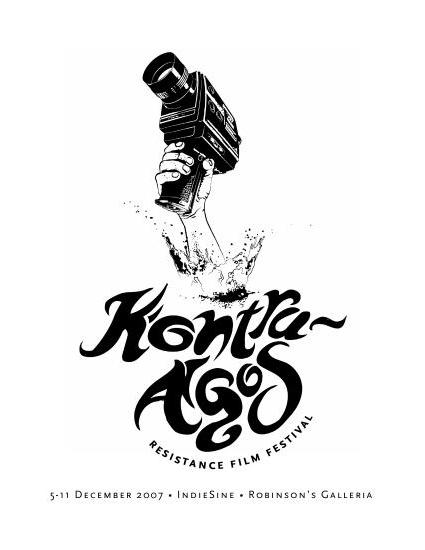
December 5-11, 2007
INDIE SINE, Cinema 3
Robinson’s Galleria, Ortigas
Tickets at P50
OPENING NIGHT
Free Admission!
7pm – cocktails and short program
9pm – opening film: WALAI by Adjani Arumpac
Visit: www.kontra-agos.blogspot.com for more details
Email: kontra_agos@yahoo.com for inquiries.
“KONTRA AGOS: A Resistance Film Festival” is a week-long film festival that will celebrate independently produced films that go against the current conventionality of popular cinema. It aims to be a venue for the convergence of a range of films that are inclined to be thematically and structurally subversive.
The idea for the festival came from filmmakers Kiri Dalena and Sunshine Matutina. Filmmaker Waise Azimi is also one of the principal organizers.
The festival is scheduled from December 5 to 11 at the Indie Sine, Robinson’s Galleria An Initiative of Southern Tagalog Exposure and Digital Cheese in cooperation with the Independent Filmmakers Cooperative.
A Photo Project on the Lives of the Families of Desaparecidos
A photograph is regarded as a powerful tool for communicating ideas in a way that a written or oral account cannot. A photograph is not hindered by language, nor does it expect its viewers to be educated or literate. The language that a photograph speaks can be understood by anybody.
It is with the acknowledgment of this power that we deemed it appropriate to use photographs as a tool for human rights advocacy. We intend to contribute to the continuing effort of sustaining and heightening public awareness and consciousness on the issue of enforced disappearances. By mounting a photo exhibit, we also intend to give a human face to the stories and struggles of the families of the disappeared (desaparecidos). We strongly believe that we can reach out to more people by telling their stories through images.
This initiative is part of a growing Artists Response against the human rights abuses of the Arroyo administration. Parallel efforts are currently being undertaken by independent and mainstream filmmakers, poets, artists and musicians. All these initiatives will culminate in a Human Rights Festival on Human Rights Day, December 10.
SURFACING, the photographers’ initiative is headed by a small working group of student photographers with advice from professional photojournalists and in coordination with the Free Jonas Burgos Movement (FJBM). FJBM is a loose network of individuals seeking for the surfacing and release of Jonas Burgos, who was abducted last April, by suspected military operatives. It also speaks against human rights abuses, in particular, of other enforced disappearances of activists in the country.
* PROJEKT DESAP can be seen at Kontra Agos from the 6th to the 9th of December.
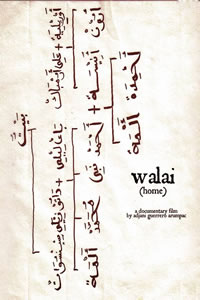 (OPENING FILM)
(OPENING FILM)
1.
Directed By: Adjani Arumpac
Synopsis:
Walai is an exploration of spaces.
It prods on the memories of four Muslim women who once lived in the infamous White House in Cotabato City. The documentary seeks narratives in “places…we tend to feel without history.” It traces the past through the women’s experience of what has happened inside the wrecked home—nostalgia and fear, loss and love, and birth and death.
(CLOSING FILM)
2.
Directed By: Gopal Menon
Synopsis: – Papa 2
PAPA 2 was a notorious interrogation centre run by the Indian Armed Forces in Kashmir till 1996. Officially, over 2000 – unofficially, over 10,000 – people have disappeared from the Kashmir Valley over the past 15 years. Most of these are enforced disappearances. The film, “PAPA 2”, documents the struggle of the mothers and wives of disappeared persons to trace their loved ones. It features interviews with the families of the affected people and also members of the Association of Parents of Disappeared People.
Screened at Film South Asia 2003, Katmandu; ivFest 2003, Trivandrum; Nottam 2002, Kerala; WSF 2004, Mumbai, The Netherlands Himalayas Film Festival, Amsterdam, 2004, SOAS, London, 2004. Invited to the Banff Mountain Film
Festival, Alberta, Canada.
Synopsis: – Naga Story: The Other Side of Silence
The Nagas are a 3 million-strong indigenous people who occupy the North-East frontier of the Indian subcontinent. The Naga political struggle is one of the oldest nationality movements in South Asia, continuing till present times. The film Naga Story provides an introduction to the history of the Naga struggle, and documents the human rights abuses suffered by the Naga people in more than 50 years of the existence of Independent India. Naga Story, which took 5 years to complete, is the first comprehensive film about the Naga struggle for identity, self-determination, peace, and justice.
Winner of the ‘Spirit of the Himalayas’ First Prize at The Netherlands Himalayas Film Festival, Amsterdam, 2004. Withdrawn from MIFF 2004 along with 6 other films as part of the Campaign Against Censorship by Indian filmmakers. Screened at the protest
festival “Vikalp 2004”, Mumbai. Invited to the Telluride Mountain Film Festival, Telluride, Colorado, USA, and the Banff Mountain Film
Festival, Alberta, Canada, and Signs 2005, organised by Federation of Film Societies India, Kerala.
About the Director
Gopal Menon’s first film was a documentary on the destruction of tropical evergreen forests in the Nilgiri biosphere. He has worked with the People’s Union for Civil Liberties (PUCL) and documented the Naga and Kashmiri political movements. Menon has also made films on Dalit issues and the communal riots in Gujarat, and worked with Channel 4 on the issue of the funding of Hindu extremist organizations.
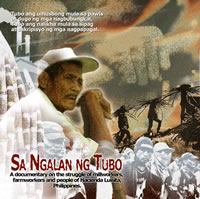 3. (Documentary)
3. (Documentary)
Directed By: a film by Tudla Productions
Synopsis:
A video documentary that chronicles what happened on November 16, 2004 when seven people died at the picketlines of the Hacienda Luisita in Tarlac. Millworkers and farm workers of the sugar refinery and plantation owned by the Cojuangcos, one of the wealthiest landed families in the Philippines, went on strike. Their demands were met with a volley of gunfire from military and police. Beginning with the history and background of the land issue, the film builds the tension gradually, leading up to the actual footage of the Hacienda Luisita incident, when even the filmmakerholding the camera had to run for his life.
About the Group
Tudla Productions (Tudla) is an alternative media group that produces video-documentaries on the plight and struggle of basic masses and on issues that bear national significance. Tudla aspires to amplify the voice of marginalized sectors in society and the burgeoning call for genuine social change and justice.
Sa Ngalan ng Tubo is among the early works of Tudla. The film was produced in 2005 in collaboration with the Ecumenical Institute for Labor Education and Research (EILER) and Alyansa ng Mga Magbubukid sa Gitnang Luzon (AMGL).
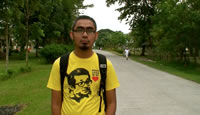 4. (Documentary)
4. (Documentary)
Directed By: Gutierrez Mangansakan II
Synopsis:
The Jihadist is an autobiographical documentary on the filmmaker’s struggle as an artist amid the backdrop of the Moro revolution. His search for his rightful place in the memory of his homeland yields questions that require him to confront his identity as a Moro and come to terms with his homosexuality.
About the Director
Gutierrez Mangansakan II is a Moro writer and filmmaker from Pagalungan, Maguindanao.
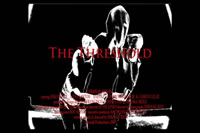 5.
5.
Directed By: Mikhail Red
Synopsis:
Seeking the threshold, the wanderer endures a dark journey into the limits of the human mind where fears and anxieties are represented by a series of rooms he must go through.
A FILM ON THE HUMAN CONDITION
“I wanted to make a film about the essence of the human mind and soul, the core of being, where every emotion is explored. The film deals about the human condition, how we are trapped and detained within the complex cells within ourselves.” – Mikhail Red
 6. (Short Narrative)
6. (Short Narrative)
Directed By: Nick Olanka
Synopsis
Virgie and Ismael are lovers in the midst of a military offensive in Sta. Filomena, a town in Southern Luzon suspected of being overrun by rebels. Virgie is a teacher of a local elementary school and Ismael is a captain of the troop assigned to infiltrate the rebels. Every Monday they meet and make love passionately and violently. One day, Virgie’s student Tikoy asks her to help find his missing father, Mang Lino, a rumoured rebel sympathizer. Events unfold and point to Ismael as being responsible for Mang Lino’s disappearance, because of this Virgie is overwhelmed by guilt. The next Monday, as they make love Virgie choosesbetween her love for Ismael and her love for her community.
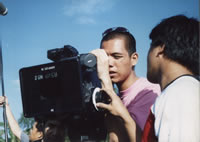
Biography of the Director
Born in 1982, Nick Joseph Olanka graduated in 2006 from the U.P. Film Institute. Active in the theater arts through the group The UP Repertory Company, he took cinematography classes in Mowelfund Film Institute. Currently training under Marilou Diaz-Abaya under Star Cinema’s directors training program.
“Monday of Sorrow” is his graduation film. In July 2006, his first feature film “Ang Huling Araw ng Linggo” (The Last Sunday) competed in the Cinemalaya Philippine Independent Film Festival and will be in the theaters nationwide in the Philippines from March 28, 2007.
7. (Feature)
Directed By: JP V. Carpio
 Synopsis:
Synopsis:
Originally conceptualized as a short film shot in 2004 and completed nearly three years later as a full length, the film charts the various emotional courses during a dinner between Emerson, a university professor, and Jenny, a university student.
The film also features the full length feature debuts of Jenny Logico and Emerson Sanchez.
Biography of the Director
Jan Philippe “JP” V. Carpio was born in Makati, Metro Manila and grew up in Bacolod City, Negros Occidental.
Returning to Metro Manila for higher education, he first took up B.S. Biology thinking then that he wanted to become a doctor. He eventually shifted and graduated with a degree in Organizational Communication from the University of the Philippines Manila in 2002.
During his stay in Metro Manila he gradually fell into writing and filmmaking.
What was then something of interest and leisure, he now calls his “purposes here on Earth”.
Largely a self-taught writer and filmmaker, he has also taken workshops under established Filipino film artists like Ricardo Lee and Peque Gallaga.
He has written and directed two feature length films shot on video.
The first in 2000, Girl of My Dreams, was made under the workshop module of the First Filipino Full Length Feature Festival facilitated by Edward Cabagnot of the Cultural Center of the Philippines Media Arts Division.
The second was Balay Dakû in 2002, the first ever full length Ilonggo feature film, produced through a grant from the National Commission for Culture and the Arts and donations from his family.
He is set to premiere several of his new films in 2007 including his third full length film HILO (thread).
Apart from a number of short films, his fourth full length film PALANGGA (the beloved) is currently in post production.
He recently completed his first documentary, the short entitled BUNKER 0: SUMIRIB PLUS, as part of a group of sixteen independent filmmakers invited by the ABC 5 television network and the newly formed Independent Filmmakers’ Cooperative to each shoot a 10 minute short film on the Guimaras Oil Spill Disaster.
Apart from his own films, he also does occasional documentation work of the performances of Dancing Wounded Contemporary Dance Commune.
8.
Directed by: Elvert Dela Cruz Bañares
Synopsis:
This is the state of our nation cycle.
About the Director
Elvert de la Cruz Bañares is a filmmaker, curator and visual artist who has been making what he calls his “little films” for the past 15 years and has, by far, independently produced 43 short films using a variety of formats. A very underground filmmaker working outside mainstream and even indie industries, Elvert’s films have been screened in underground and international film festivals in the United States, Australia, China, Singapore, Japan, South Korea and Canada.
He has curated first time Filipino programs for the ‘Queerfest: Vancouver Gay & Lesbian Film Festival’ and the ‘Antimatter Underground Film & Video Festival’ in Victoria, Canada. Twice he was sent as Philippine delegate to first time Filipino Film Festivals in Beijing and Shanghai, People’s Republic of China.
Elvert has been festival director and film programmer of ‘eKsperim[E]nto Festival of Film, Video & New Media’; ‘Chinese Film Festival’; ‘The NCCA Film Club’; and the ‘ASEAN Film Festival’ (at the Podium).
His awards include the Gold Medal for Excellence in Scriptwriting for Radio, TV & Film awarded by the Media Arts Foundation; the 2nd Prize for 1987 Annual Art Association of the Philippines (AAP); and three (3) Gawad CCP for Independent Film & Video.
He has just finished (producing and directing) the latest music video for international artist, Swan Dive, and is currently finishing his full-length films, “Alipo-op Sa Animo” (Fog In The Consciousness) and “The Atomika Settlement: Devastation Canvas 5”.
Elvert has been schooled at the Sta. Maria Catholic School (now, Ateneo de Iloilo), West Visayas State University, Institute for Arts & Cultural Management and the Asian Institute of Management (AIM). An Ilonggo by heart, he is currently based in Manila, Philippines.
 9.
9.
Directed By: Gabriela Krista Dalena
Synopsis:
Children of the Land faithfully guard the last harvest from thieves. This poetic film offers a glimpse into the passion and pain of the people’s protracted war in the countrysides.
(MINDANAO FILMS)
10.
Documentary
Directed by: Eduardo C. Vasquez, Jr.
Synopsis:
Me’guyaya is a Te’duray term for merry-making or thanksgiving. In 2003, an active and concerned group of people in Upi, Shariff Kabunsuan initiated a festival that would unite all residents in thanking God for the abundant harvest. Since then, it has become a big town event that celebrates the richness and diversity of the Muslim, Christian and Lumad peoples of Upi.
The documentary delves on how the Me’guyaya serves as a catalyst for
cultural unity as everyone gets involved in the festivities.
About the Director
Eduardo C. Vasquez, Jr., OMI is a Catholic Missionary priest who belongs to the Congregation of the Oblates of Mary Immaculate (OMI). He is presently assigned as the parish priest of the San Isidro Parish in Upi, Shariff Kabunsuan. He is the founder and the present director of the “I-watch Team” which produces short video documentaries advocating Justice, Peace and Integrity of Creation. Fr. Vasquez has earned his Masteral Degree in Pastoral Ministry at the Loyola School of Theology in Ateneo de Manila University where he graduated Cum Laude. In 2003, he earned his diploma on Religious and Social Communication in CREC-AVEX, Ecully, France.
11.
Documentary
Directed by: Loren Hallilah I. Lao
Synopsis:
The documentary delves on the good governance efforts of the private sector, civil society and the local government unit of Wao, Lanao del Sur working together to erase remnants of the religious and ethnic clashes of the 1970s. It explores how peace has been achieved in this multi-ethnic town, propelling the once-turbulent municipality into its present agricultural renaissance.
About the Director
Loren Hallilah I. Lao is an Instructor at the English Department and Communication Studies Program of Mindanao State University, Marawi City. A lawyer, she is also a Lecturer at the College of Law of the same University. At the same time, she writes fiction and dabbles in filmmaking.
12.
Documentary
Directed by: Moises Charles Hollite
Synopsis:
George Sabandal is one of about 2,500 internally displaced persons (IDPs) who have sought refuge in the town of Buluan, Maguindanao as a result of the “all-out war” in 2000. Refusing to go back to the place of his origin, he has created a new life for himself and his family in their ideal town.
About the Director
Born in 1980, Moises Charles Hollite initially wanted to pursue a career in music. But having worked as production assistant in four documentaries changed that. Influenced by MTV, George’s Town is his first directorial film.
13.
Documentary
Directed by: Al Jacinto
Synopsis:
Born of a Muslim mother, young writer Arthur Sakaluran Abasalo decides to visit Sulu despite the perceived strife and presence of Muslim rebels and Abu Sayyaf terrorists. In Sulu, he meets a former Muslim rebel-turned policeman who tells him about his life story and how he got separated from his family for more than a decade. He returns to Sulu to start a new life after being reunited with his family.
Arthur returns to Manila after a short stay in Sulu, bringing with him memorable stories and truths about the island feared by many as a dangerous place to go.
About the Director
Al Jacinto is a freelance journalist, a photographer and a budding independent filmmaker. He co-produced a 10-minute documentary-MTV on the poverty situation in Zamboanga City in southern Philippines entitled Pobreza en Zamboanga. And made a full-length film entitled Sultan in Mindanao and several short photo-documentaries about poverty since 2006.
14.
Feature
Directed by: McRobert Nacario
Synopsis:
A story depicting the process of preparation and cooking of a dish called Biniton that is particular to the community of Saniag,
Ampatuan. The process of cooking, in the eyes of an old woman, brings to life the hardships they experienced amidst armed conflict at the same time the process of preparation, through the experience of Amel, her grandson walks us through the current situation of their community. How amidst the hardships and diversity in culture they had all managed to bounce back and become united.
About the Director
24-year-old McRobert Nacario has worked in various documentaries and feature films. His keen eye for detail is evident in his works making his films a sumptuous visual feast.
15.
Feature
Directed by: Mona Labado
Synopsis:
Seven-year-old Abdul dreams of becoming a leader of his town. He has natural charisma and easily becomes friends with people even if he hasn’t known them for long. But his grandmother reminds him of their peasant roots which is no match to the traditional ruling family. Undaunted, Abdul sees it as a challenge envisions his future.
About the Director
A computer engineering graduate, Mona Labado was gravitated to the world of cinema when they were asked to make video projects in college. Together with her friends, she has made a few documentaries and short films. A Step for My Dream is her directorial debut.
16.
Feature
Directed by: Sheron Dayoc
Synopsis:
Nine-year-old Satra has been mute for as long as she could remember. But her determination to secure a good education reverberates clearly amid the strictures of her Yakan culture.
About the Director
Sheron Dayoc is a philosophy graduate of Ateneo de Zamboanga University. Trained at the UP Film Institute, he has produced several documentaries on the untold stories of marginal people and different tribes in Mindanao that has enriched both his personal and creative life.
17.
Documentary
Directed By: Waise Azimi
Website: www.standingupthemovie.com
Synopsis:
STANDING UP is a feature length documentary young Afghan men training to become professional soldiers in the new Afghan National Army. Situated at the Kabul Military Training Center, Standing Up chronicles the struggles and lives of these Afghan men from the moment they arrive at the KMTC to the last day of training of their training. Extensive access to the KMTC training program has provided an insiders perspective into one of the most underreported and important stories in the War Against Terror, the story of those who are Standing Up to the first line of defense.
Biography of the Director
In June 2006 the documentary-maker Waise Azimi embedded at Camp Alamo, the Coalition partner-base to the KMTC. He spent four months with the men of Battalion 55 of the Afghan National Army and alongside US and Canadian soldiers from the Combat Arms and Collective Exercise Training sections of Training Assistance Group V. Previously, in 2003 Waise Azimi made Afghanistan After, a short film about how Afghan society had changed two years after the fall of the Taliban. Waise Azimi earned a degree in Sociology from Bard College in 2005, he currently lives in the capital of the Philippines, Metro Manila.
 18.
18.
Directed By: Noriel M. Jarito
Synopsis:
Bingo reveals life’s monotony of rural existence. People embrace almost anything: dull, inspiring, tame, untamed, reputable, and even deceptive. Their horizon is bounded by beliefs which sometimes manage to mislead, mock, and misuse their fate. They surrender and never question the path they trace. Thus, they are lost. Submission is sweet, to do otherwise is bitter. Their incomprehension is at the maximum level that wrong becomes right, and what is right becomes wrong. To play “Bingo” inside a church is never questioned and is labeled licensed by some unprincipled Catholic Church leaders. Christianity is the largest religion and surely many of its followers are destitute enough to consider “Bingo” inside their church as a source of momentary abundance.
Bingo reveals all: People are born. People are being baptized. People marry. People die. All these should have been valuable and symbolic, yet have gone awry and worthless instead. Why? Because of people’s shallowness and ignorance.
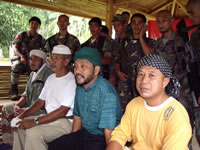 19.
19.
Documentary
Directed By: Anna Isabelle Matutina and Herbert Docena
Synopsis:
This documentary contextualizes the issue of US military presence in the country within the long and bitter history of conflict in the south. Countering the reductionist frame set by the narrative of the “global war against terror,” it examines the historical conditions that led to the emergence of the Moro separatist movement and the subsequent rise of the Abu Sayyaf. It dissects the government’s contradictory attempts to downplay its threat while at the same time justifying escalating military operations in the region.
Against this backdrop, the documentary then probes allegations of US military involvement in the war.
20.
Documentary
Directed By: Emmanuel A. Dela Cruz
Synopsis:
A documentary work in progress, “The Singh Family Home Videos” charts an intimate look at the family life of the filmmaker’s neighbors, a Punjabi Indian family who has assimilated into the Filipino culture and community. Is nationality a matter of origin? Is identity a matter of choice? Or is your “home” a matter of where you are or where you’ll be?
A fictional narrative feature based on this work, tentatively called “1434456” is slated to be produced in 2008 by the inependent
film group, UFO Pictures(“Ang Pagdadalaga ni Maximo Oliveros,” “Sarong Banggi” and “Endo”) and is vying for a Cinemalaya
subsidy.
21.
Directed By: John Torres
Synopsis:
Voice, Tilted Screens is, at once, a meditation. It is a meta-film that unravels a journey, a chronicle of stories through foreign regions. It is a probing letter from outside circles, an honest account of illegitimate views from uneven terrain, and a narrative- driven exploration of the nooks and peripheries of the body, geography, and weather. As the journey progresses, the film increasingly traverses the countries of revelation, film, and heart to where all journeys are meant to end with.
 22.
22.
Short Narrative
Directed by: Mariami Tanangco
Synopsis:
A Rookie cop gets baptized into the world for crimefighting – Manila style.
Director’s Statement
The inspiration for “Binyag” came from a conversation that I had with a police officer three years ago. He told me the story of his own “baptism” into the Force – he was dared by his senior companions to execute (or “salvage”, in a street lingo) a suspected felon.
It was one bloody story, on that involve power-tripping, “macho” aggression, modern-day savagery. But what disturbed me most was the story was being told in a tone that was jaded and unapologetic – by someone whom I have always known to be a good man.
He was quick to tell me that “salvaging” used to be a prevalent—though illicit—practiced during the early-to-mid-90s. It was a thing of the past. But I don’t doubt the impact that those years have made on the person that he is now.
On a personal level, the film is elegy—on goodness lost, on brutality born from a culture of violence. People have lost their lives; some have lost their innocence; mothers have lost their sons, to the culture of violence that prevailed back then.
It’s a tragedy that some people are already sentenced to die before they even reach the courts; but it’s also a tragedy to see how a morally depraved system can transform God-fearing individuals into killers who are hungry for blood.
 23.
23.
Directed By: Ruelo Lozendo
Synopsis:
A worm enters a man’s ear and lives inside his body. As the worm’s metamorphosis unfolds, the man experiences his own transformation.
Biography of the Director
Ruelo lives and works as a filmmaker in Manila, collaborating with artists from different disciplines, such as contemporary dance and music. He started out as cinematographer / editor in a number of film and TV productions. He received a grant from the National Commission for Culture and the Arts, and was a finalist of the Cinema One Originals Digital Movie Festival 2006.
His works have been exhibited in the USA, Singapore and other countries.
24.
Short Narrative
Directed by Jeck Cogama
Synopsis:
…
REPRESSION BREEDS RESISTANCE
A Statement on the Censorship of Kontra-Agos Films “A Day In the Life of Gloria” and “Mendiola”
What defines democracy isn’t simply freedom of expression; it is, in liberal terms, freedom of criticism. The people not only have the right to expose or bring into public discourse the wrongdoings of the government. It is also their democratic right to condemn it and call for or take actions against it. Any government which takes away this freedom can only be called tyrannical.
In yet another attempt to silence the voice of dissent against the current administration, the MTRCB Members Orense, De Leon and Del Prado gave an X-rating to two short films scheduled for exhibition in the Kontra-Agos film festival: “A Day in the Life of Gloria” and “Mendiola”. An X-rating automatically bans the films for public exhibition. The two films are unapologetically critical of the Arroyo Administration. A Day in the Life of Gloria depicts the lies and the human rights violations committed under the Arroyo regime. Mendiola is a short documentary critical of Arroyo’s calibrated preemptive response policy. Obviously for the MTRCB, such criticisms are not fit for public exhibition. The board members made it so obvious by even blatantly stating that they are a government agency and it is therefore their mandate to protect the incumbent government, a clear indication that the MTRCB is no longer committed to working in a democratic space. Apparently, the board members have forgotten that their mandate emanate not from their boss, but the people.
The behavior of the MTRCB is, of course, not any more surprising. A few months before it gave an X-rating to Kontra Agos films, the omnibus film “Rights” met the same fate. It was only after the filmmakers protested the decision and the incident got picked up by mainstream media when the MTRCB reversed its decision. In both instances, the MTRCB trumpeted Section 3 of Presidential Decree No. 1986 declaring that the films “undermine the faith and confidence of people in their government and/or duly constituted authorities.” In the corridors of the National Press Club, on the other hand, the mural painted by the Neo-Angono Artists Collective was bastardized when certain elements of the painting that are critical of the government were altered. The treacherous act, it was revealed later, was committed in connection to the attendance of the president in the launching of the mural.
In the case of films given an X-rating, the obvious censorship is aggravated by the fact that the fees charged by the MTRCB for review is exorbitant for independent and alternative film productions. Thus, appealing for another review, which corresponds to another payment, becomes doubly difficult if not entirely out of the question. Suffice it to say that there is a palpable air of paranoia and suppression that surrounds the government.
For the MTRCB to ban the films on the grounds that they undermine the confidence of the people on duly constituted authorities is lame and ridiculous. It is a fact that for years now, independent surveys conducted by groups like Social Weather Stations and Pulse Asia indicated that majority of the people do not trust the president as expressed in her negative satisfaction ratings. What is even alarming is the pronouncement of the board members of the MTRCB expressed during the deliberations of the films. Not trying to conceal its true colors as the Arroyo administration’ s “censorship body”, an MTRCB board member said that that the works are not protected by freedom of speech and they are bound to uphold not just an MTRCB implementing rules and regulations but a Presidential Decree. What is clearly happening is we are being ripped of our right to criticize the Arroyo administration.
Any sensible artist or person for that matter can clearly see that the censorship is simply a symptom of the mounting mistrust of the people that the Arroyo administration handles through repressive schemes. And for as long as the Arroyo administration and it’s appointees in the MTRCB continues to enforce rules that curtail our right to express legitimate dissent and prevent the people from free accessing information, we as artists and citizens will strengthen our ranks and will continue our resistance against censorship and the growing tyranny of the Arroyo administration.
Kontra-Agos Resistance Film Festival Organizers
December 8, 2007
A Few Good Words On Resistance Cinema
Amos Vogel
… Was determined to “demonstrate that there is an alternative to industry-made cinema that is more in touch with the practical and spiritual lives of individuals, whether these lies are documented by committed filmmakers or expressed in abstract or psychodramatic imagery.”
“film going was more than a process of experiencing, over and over, the particular codes of commercial genre film, or worshiping the physical beauty or the dramatic ability of the stars; it was a means of getting in touch with the immense and fascinating variety in the way people live and with the myriad ways in which individuals express their inner struggles.”
Scott Macdonald, Introduction to A Critical Cinema
When viewers are faced with forms of film that cause them to wonder, “is this a movie?” they have the opportunity to recontextualize their previous film going experiences and expand their understanding of what film and film history is, has been, and can be. The inevitable conventionality of the popular cinema – “inevitable” because without established conventions, movies cannot be popular enough to return a profit on the financial investments necessary to produce them — continually re-creates an audience with a set of predictable expectations and, therefore, with a considerable potential for surprise. If the achievement of the American film industry has been its ability to maintain its economic viability for nearly a century by continually reenergizing a narrow range of film going pleasure, the achievement of the critical cinema, which has been evolving at the margins of the popular cinema, has been the continual proliferation of critical film forms —that is, forms of cinema capable of surprising viewers and catalyzing critique—by filmmakers with limited economic means. Indeed, this proliferation has been so extensive that even naming it has been an endless cause for debate: what I am calling “critical cinema” includes “avant-garde cinema,” “revolutionary film,” “poetic film,” “film as art,” “the New American Cinema,” “film as subversive art,” expanded cinema,” “alternative cinema,” “visionary film,” structural film,” “punk film,” “trash film,” “experimental film,” “abstract film,” “the new narrative,” “materialist cinema,” “independent film,” “third cinema,” “transnational cinema,” and “queer cinema.”

 PROJEKT DESAP
PROJEKT DESAP